Digital synthesizers are awesome. When you don't have to rely on the natural tendencies of analog components to create or modify sound, an entire world of new possibilities emerges: a world in which any concept of how to create and control sound is suddenly within reach. Digital synthesis provides designers a platform to explore their ideas about sound in ways impossible to achieve with analog technology—so, while I love analog synthesizers, I am 100% on board with digital synthesis in general.
And seemingly out of nowhere, there is a new digital synthesizer in the world: the Ashun Sound Machines Hydrasynth. Ashun Sound Machines (ASM) at this point is likely not a familiar name. Until today, they were shrouded in secrecy. It is rare for a company to emerge so suddenly with products basically ready to go—but ASM is full of industry veterans who have pooled together to create something truly fascinating.
The Hydrasynth is a "digital and proud" synthesizer available in both keyboard and desktop formats. Its feature set is astounding: polyphonic aftertouch, Wave Scanning oscillators, loads of oscillator modification options, two filters, five complex envelopes and five complex LFOs per voice, extensive internal modulation routing options, CV and Gate I/O, a more-than-fully-featured arpeggiator, built-in effects...the list goes on.
Having now spent some time with the Hydrasynth, I believe that it is safe to say it is unlike anything else available. It is clearly the product of a lot of careful thought, created by people deeply interested in synthesis, performer experience, and every hidden corner of sound design. I was lucky to be able to talk with one of these people: Glen Darcey, the former head of product management at Arturia, now in place as ASM's design director. Glen has a wealth of experience with synthesis and has clearly spent a lot of time and thought making Hydrasynth exactly the instrument it should be—and happily, he had a lot to say about it.
Background and Introduction to ASM
Ryan Gaston: Hey Glen! We're super excited about the sudden appearance of Ashun Sound Machines and the Hydrasynth—not often does a new company make its debut so suddenly! What can you tell us about ASM as a company?
Glen Darcey: Yeah, it is kind of unique. There are some good industry veterans here though. The core of the company is myself (heading up product and vision), Dominic Au (Product manager), Chen Jiejun (director of engineering) and Daniel Troberg (heading up sales). There are many others helping out of course, but we are setting the flavor of the brand and directing the product line.
We didn’t want to announce the product early. I personally hate when companies tease with videos that don’t say anything other than “coming soon” or announce stuff six months or two years before it is a reality, so my goal was to drop it all at one time. I feel very lucky that we were able to keep it under wraps so well.
RG: You personally are familiar to us from your days at Arturia—how did you come to be involved with ASM? How does your prior role in product management at Arturia translate over to your current role with ASM?
GD: I had been at Arturia for six years, and while I was very proud of the stuff we made and accomplished, this opportunity came up and offered me some new challenges as well as some exciting possibilities and more creative control.
My job at Arturia, and Akai before that, is the reason I got this job. I was lucky enough to have people who trusted my instincts on some products that were risky at the time. The Akai MPK line, the APC40, MPC5000, MAX49 (first controller with CV/GATE), and I laid the groundwork for the MPC Renaissance and Studio. At Arturia, we made the first analog synth with a keyboard to come out in a long time [Ed. note: the Minibrute]. It helped reignite the analog push in the marketplace. At Arturia, I was able to work on hardware and software and get a lot of good feedback from users and the market.
All that translates to what we are doing now. The goal is to be doing stuff that others are not doing. Either in a way the competition may not have thought about or are just not able to do for some reason. Our Polytouch™ keybed is an example. Polyphonic aftertouch is not new but it takes some special resources to be able to do the tooling and make it be responsive and musical. The factory we are partnered with had the resources to make it a reality.
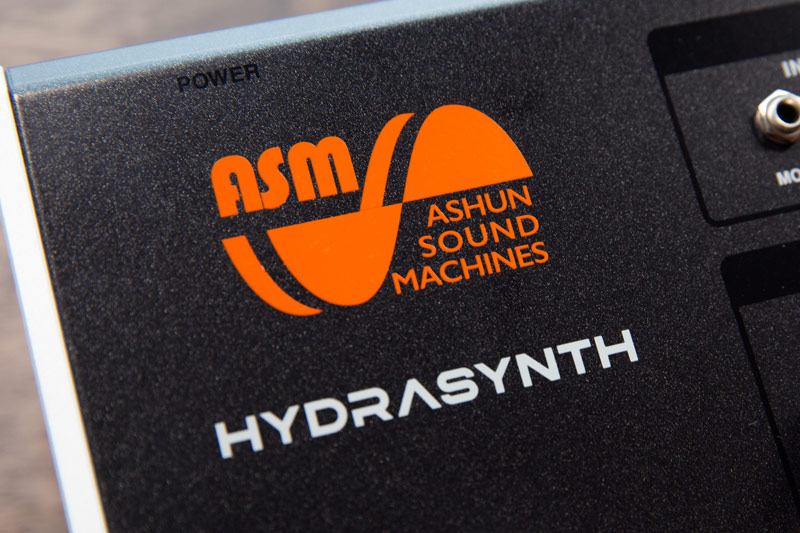
RG: Young companies have the unique challenge of not only making cool instruments, but of defining who they are, and how to present themselves. What is the driving force behind ASM? How do you conceptualize the company's overall mission?
GD: I would say that our main goal is to make musical instruments. Not just gear or products, but musical instruments that help people express themselves and can have some lasting quality to them. We all believe that making music makes people's lives better...yeah, it sounds corny, but we really believe that. If we can add some features or bring something that gives someone a new idea and makes them want to spend time making music, then we succeeded. So I guess our mission is to be fun, make good music products and be a positive force.
Hydrasynth In Depth: Sound Engine
RG: So, on to more instrument-specific questions. In a nutshell, how would you describe what the Hydrasynth is?
GD: Oh, that’s hard. It is a wave morphing synthesizer at the heart of the oscillators. You can put eight single-cycle waves of your choice, from a list of 219, and then morph between them. But then the Mutators allow you do things like FM synthesis, three different flavors of pulse width modulation and wave bending, OSC sync, harmonic sweeps, Wavestacking…all this before going into two filters.
So it is a wave morphing synthesizer, but you can do legit FM synthesis on it, and it can do VA analog types of things and then mix and combine all of that. It is really a very deep hybrid of all those things.
RG: The Hydrasynth's feature set is pretty nuts—it seems to combine features from lots of classic synths, and adds a lot of concepts that seem entirely unique. When planning the instrument, where did you look for inspiration?
GD: Lots of places for sure. Dominic and I are both synth heads. We both have a big collection of new and vintage stuff. For me, the poly aftertouch of the Prophet T8 was a huge inspiration. It’s my favorite instrument to play. It’s so playable and adds character and life to the sound. At the same time, I have an Ensoniq TS-10 with poly aftertouch that is horrible to play…we made sure ours was along the lines of the T8 for feel.
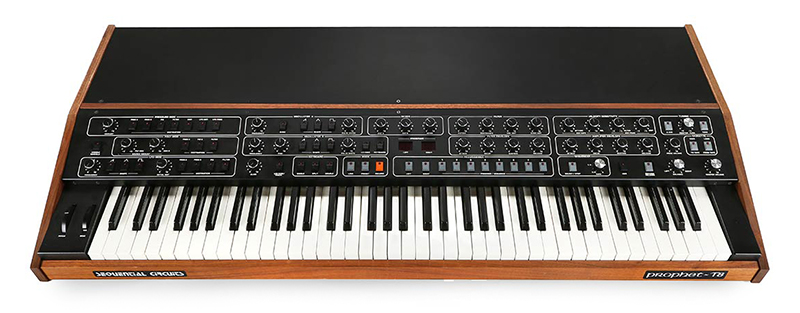 The Sequential Circuits Prophet T8
The Sequential Circuits Prophet T8
The Oberheim Xpander with the 5 envelopes and 5 LFOs and a similar editing workflow is an obvious influence—both Dominic and I love the Xpander. Historically, the PPG and Prophet VS types of sounds are something that I gravitated towards, so getting a hint of those sounds was key to me. Some of the wavebending stuff that Serum does was an influence for sure. Dom wanted to have a synth with the power of the computer plug-ins but in hardware.
Back in the early '80s I hated when synths started taking features away. I know people love the Juno 106, but to me it was the worst thing to happen to synths at that time. The 106 and the Poly 6 and others were about how many features can you remove and still get a synth-type sound. Now there can of course be beauty in simplicity—I think we did that well at Arturia on the Microbrute for instance—but my heart belongs to the flexibility you get in the modular world.
RG: Because the instrument is so dense, I feel compelled to ask some module-by-module questions, just to clarify the potential of some of the individual components of the signal chain. Starting with the oscillators—if I'm correct, two of the three oscillators for each voice can operate in "WaveScan" mode. What is Wave Scanning? (And in what ways is it similar or dissimilar to wavetable techniques?)
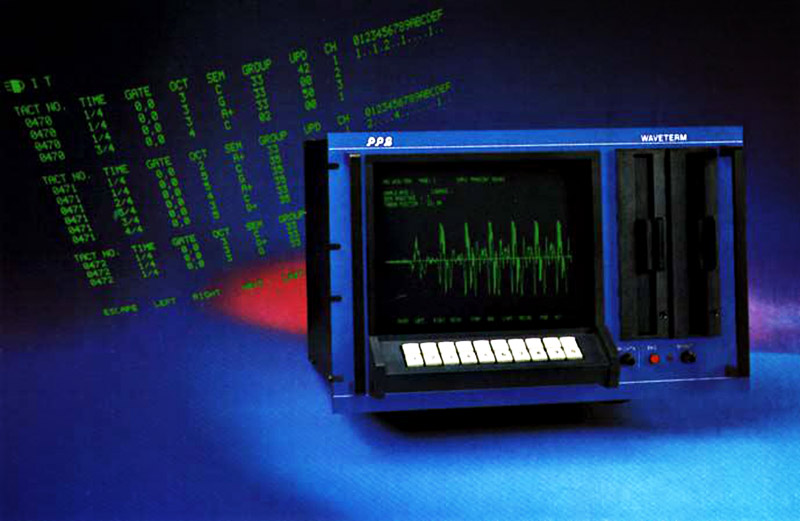 The PPG Waveterm, from original product brochure
The PPG Waveterm, from original product brochure
GD: Wavescanning is being able to go from one waveform to another smoothly. Most wavetable synths have a bunch of premade tables where they have chosen the waves they are scanning from and to. While the tables will have 64 or 128 waves, most are just intermediate waves between two or three main waves. The tables might go from A to B or C to D but if you want to go from A to D to C to X, then you can’t do it. Our is more flexible in that you have 219 waves and you can arrange up to 8 of them in a Wavelist and move through them. You can do this on Osc 1 & 2 separately...and every patch can use a totally different Wavelist. So it is similar to the PPG (with a Waveterm) or the Fairlight, in that you could place your own waves in a table and then scan from one to another.
RG: One of the first things that caught my eye when I saw the Hydrasynth were four buttons labeled "Mutant." With oscillators that already produce a broad range of timbres, what do the Mutants bring to the table? How do you find yourself using them?
GD: The Mutants, or Mutators collectively, add more processing of the incoming sound. Each Mutant has Linear FM with multiple modulator options, Wavestack™ (think super saw), OSC sync with selectable sources, Harmonic sweep, and three types of Pulse width mod: ORIG, SQUEEZE (smoother sound than orig), and ASM mode, which divides the wave into 8 slices and you can choose how much PWM is on each slice.
They can do so much sound shaping that, personally when I was doing my bank of sounds, I barely used the filters at all. You can feed single waves into them or do PWM and then FM on a scanning wavelist. You can do incredibly complex stuff using just one oscillator and two mutators. These are where the magic and possibilities really open up.
RG: The filter section also has a number of uncommon options—lowpass gate, vowel formants, and models inspired by classic synth designs. How did you settle on the filter types to be included?
GD: We mainly picked a bunch of filters we liked and wanted. I love the richness of a LPG. We needed to have a ladder style, both compensated and uncompensated. Ken “flux” Pierce of Fluxwithit.com introduced us to the Threeler filter, which is huge-sounding (I need to get an original one in my modular). Anyone with a modular should own one of those.
Chen came up with the vocal filter and asked if we wanted it…which we said of course…then I asked if we can arrange the vowels in different orders so he gave us a list of 8 different vowel orders. The interesting thing on the filters is how Chen made them. His background is first in math but then also AI. So we made recordings of the filters we liked, with a bunch of combinations of cutoff and resonance settings and he wrote a machine-learning program that analyzed the audio files and then recreated the profiles of them. So our filters are made via his Neural Network Filter modeling.
Hydrasynth In Depth: Modulation
RG: The modulation section is deep, to say the least. CV input and output, five DAHDSR envelopes, five LFOs, user-definable "Step" LFOs, dynamic modulation matrix control...the envelopes can loop, and the LFOs have a one-shot mode! Looking at all these options on paper makes the Hydrasynth feel an awful lot like a huge modular system. How did you decide on the final set of modulation options?
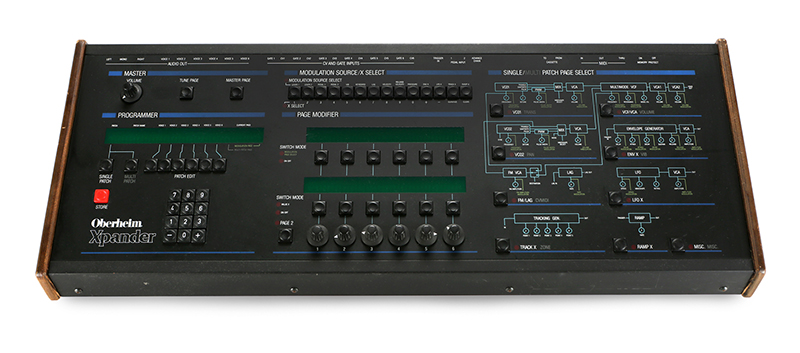 Oberheim's Xpander: a treasure among modulation lovers
Oberheim's Xpander: a treasure among modulation lovers
GD: Much of the mod options started with Dominic’s ideas that he wanted. I always loved my Oberheim Xpander's ability to have anything set as a mod destination. I love the Maths module Log to Exp settings so we added those. It was all just Dominic and I going crazy…and Chen didn’t stop us and kept saying he could do whatever we asked.
One thing I always wanted personally was envelopes that had the time based on clock, so you could set the attack to a quarter note and the decay to a half note, so that when you changed the incoming clock, you would not have to get tweeky with your envelopes. I have not seen it in other hardware…it might be there, but I haven’t seen it. When you combine that with the looping in the envelopes, it allows a lot of tempo-based modulations.
So yeah, modular is a big influence. I learned on a modular in the early '80s. Dominic has a modular, both Roland system 100m and Eurorack. It’s just where we come from.
RG: Seeing dedicated CV inputs and outputs on a standalone synth is awesome. How might someone integrate the Hydrasynth into a modular-based workflow (and vice versa)?
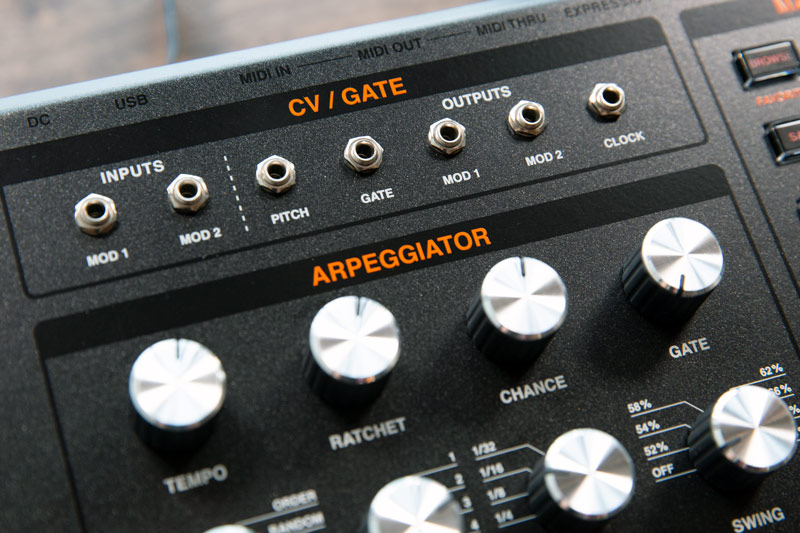 CV I/O Section on the Hydrasynth
CV I/O Section on the Hydrasynth
GD: Oh, there are many ways. The MOD inputs and outputs can handle DC to audio range.
For the outputs, you can use any of the mod sources and send them to your modular. You do this in the mod matrix so you have full control over them. You can send multiple mod sources to a single MOD output and get really complex. You could even do something like take a MIDI CC as a mod in from a DAW, route it to the MOD out CV in the matrix and do crazy stuff like that.
The MOD ins can go to any modulation destination, which is 95% of the stuff in the engine, so if we don’t have a mod source you want, use your Eurorack modules instead. In the Mutant FM mode, you can choose Mod1/2 as the modulator, so you can do FM with external sources.
One trick you can do is process external audio in the Hydrasynth. Since the Mod ins can take audio range signals, and we have a Ring mod with selectable inputs, you could choose Mod in as Ring Mod source, set the Ringmod depth to 0 and then turn up the Ringmod in the mixer…and you have audio input to the mixer. Additionally, you could route Mod 1 in to the mod matrix, route it out to MOD 1 or 2 out and use the mod matrix as an attenuator…one that can be controlled via another mod matrix source…you could set the macros to send knob values to the MOD outputs and use them as voltage controls...the possibilities go on and on.
Hydrasynth In Depth: Interaction
RG: Both the desktop and keyboard have some pretty remarkable expressive capabilities. The keyboard has a huge ribbon controller, both versions offer polyphonic aftertouch, and, of course, both versions have a pretty insane arpeggiator (with probability-based ratcheting, novel note order options, and sequence-like behavior). How did you arrive at this combination of user controls, and how do you find yourself using them?
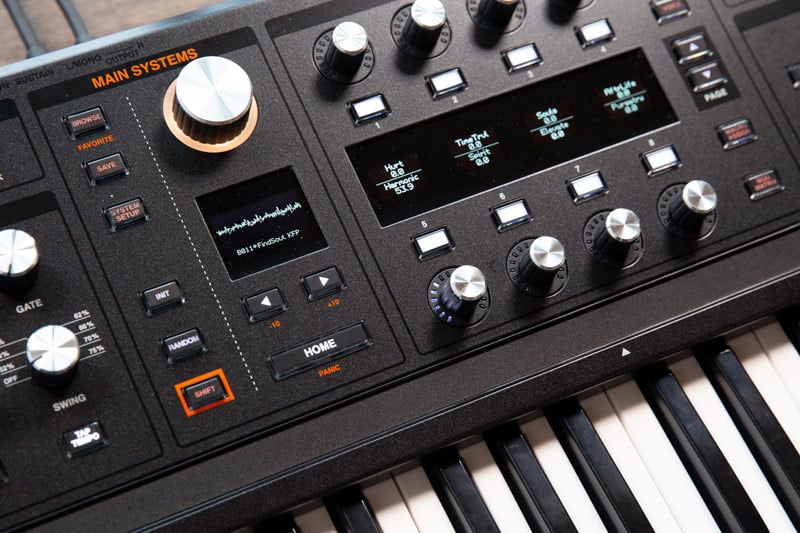 Hydrasynth's panel controls, with the all-important Random button
Hydrasynth's panel controls, with the all-important Random button
GD: Polyaftertouch has been my holy grail for a number of years but nobody had the resources to do it. The ribbon started off small like some other brands but I find them pretty useless. I loved the big ribbon on the CS-80 and on the Arturia Origin.
The polyaftertouch is mostly used for timbral changes, like opening a filter or scanning a wave or added FM or PW mod. Add a bit of control of the amp and it gives you great Vangelis types of pads. It's great to be able to hold a chord and have just one note be accentuated. Even if you are using it on a chord, since each finger has a different amount of pressure, it has a much more natural sound than standard mono aftertouch. Once you try it, you will not want to go back.
The ribbon can be used for pitch bend or as a mod source. It can be used to open filters or again scan waves or add LFOS...just like you might use a mod wheel. We have multiple options for how it works in the mod source list so there are many ways to do things. Maybe you want it to open the filter in relative mode, so from where your finger hits, it will open or close it and do absolute mode to change parameters in the arp...again, too many options to list.
The most fun part of the arp is that most parameters can be mod destinations. So you can be changing the mode via an LFO or time division by aftertouch or ratcheting via a looping env…the arp is also additive, meaning that if you are holding notes, you can keep adding notes. So playing a three-note chord, if you repeat the top note while holding the others, it will make that note repeat. So you can create different note patterns in real time.
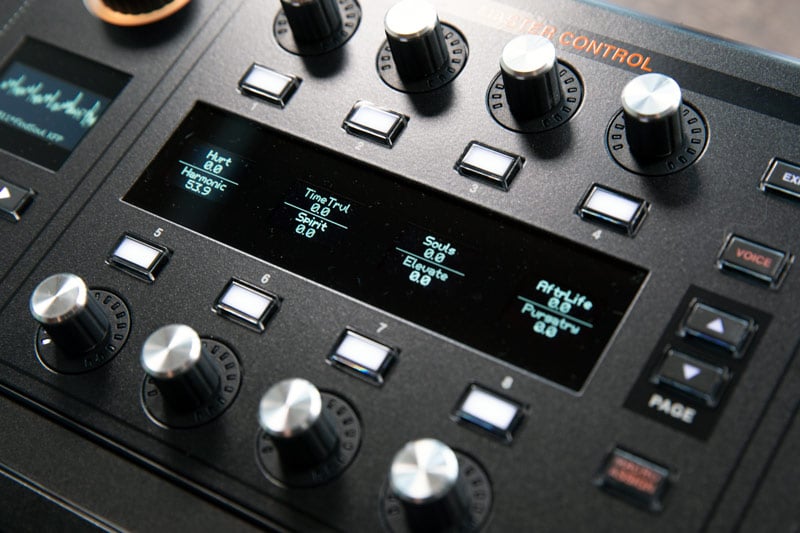 Hydrasynth's Macro Control area
Hydrasynth's Macro Control area
RG: Beyond the level of the raw synthesis elements, effects, and typical user control options, the Hydrasynth offers user-definable Macros. What are Macros? Can you provide a couple of examples of how someone might use them?
GD: The macros allow you to have front-panel control of parameters. Since the synth is deep and we can’t have a knob per function, having the macros allows you to have hands on control of some parameters for each patch. You can control up to 8 parameters and set individual amounts both positive or negative. It is a nice way to load a patch and be able to turn a knob and have something happen. When you save a patch, there are few save options for the macros. You can save the current value. So if you edit a patch and like the macro position, it will save it. You can have it not save the position, so it will always return them to 0, or you can convert the position to real parameter changes, so it will edit the voice settings itself. I use SAVE position 99% of the time myself.
RG: For me, one of the most fun and unexpected features is the extensive option for randomization—it reminds me a lot of the patch randomization function in the Prophet VS! Where did the idea for randomization in the Hydrasynth come from, and how do you expect that people will use it?
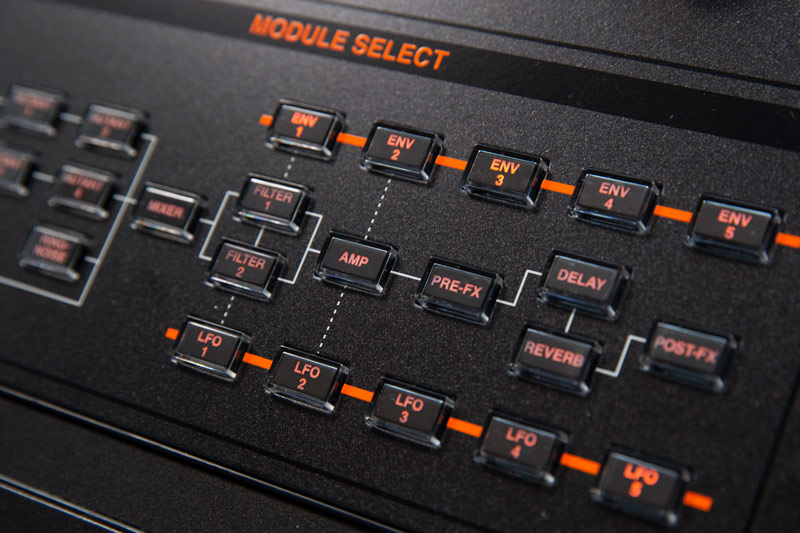 Hydrasynth module select buttons
Hydrasynth module select buttons
GD: Randomizing is fun. You get unexpected results and it is a good way to generate new ideas. Sometimes the random generates something useable and sometimes it does stuff that generates no sound…it’s a coin toss.
We do allow the user to randomize specific modules. If you hold RANDOM and press one of the MODULE select buttons, it will randomize the parameters in that module alone…this is more controllable and very interesting.
You can do the same with INIT. You can INIT a patch or just a module.
New Sounds for Years to Come
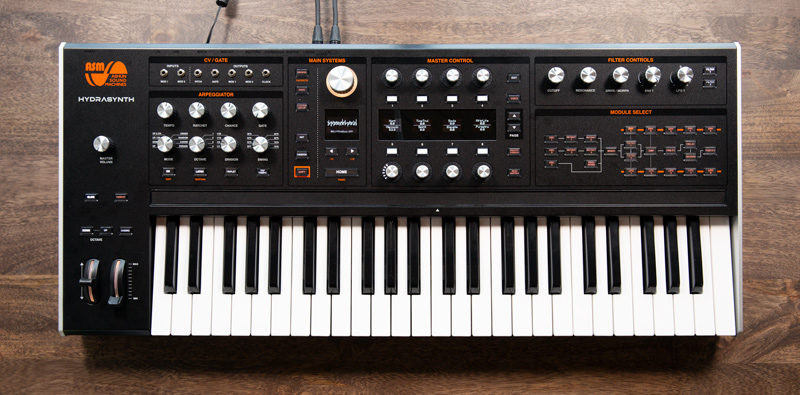
RG: It seems safe to say that the Hydrasynth is fairly unique. What aspects of the instrument are you most proud of? What aspects, from your perspective, set it aside from other devices on the market?
GD: I love the Wavescan. Again, it goes back to me having always wanted a PPG and a Prophet VS. The poly aftertouch is huge to me. There are many alternative controllers out there offering interesting control but you have to learn a new technique to play them well. Poly aftertouch takes very little to learn to play it.
The synth engine is really deep but really easy to use. All the sound design team was amazed that they were making sounds within about 10 minutes of using it. There are of course deeper functions and features, but nothing is buried too deep, and even those things can be gotten to fast in a couple of ways.
The sound is great. Features mean nothing if the user interface is no fun to use and if the product doesn’t sound great, so I think we avoided the pitfall and nailed the important things.
RG: Who is the Hydrasynth going to really benefit? Who is going to be most excited by the Hydrasynth's possibilities?
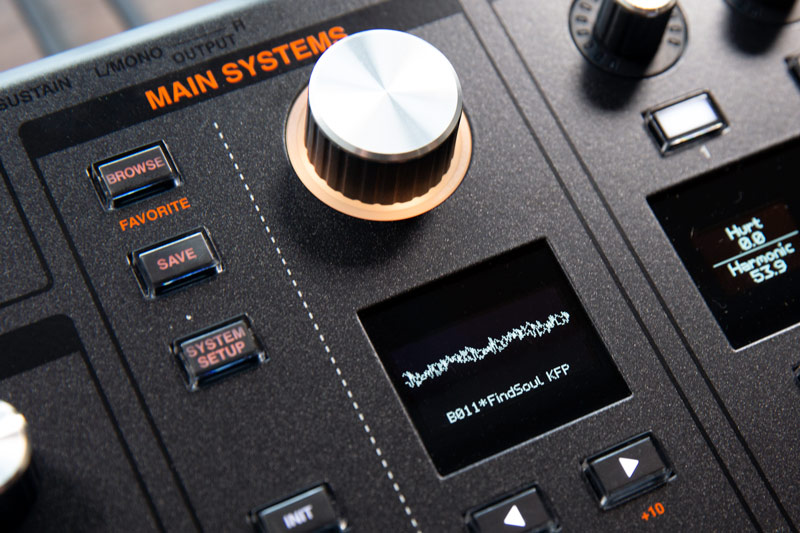 Waveform display on the Hydrasynth, constantly updating in real time
Waveform display on the Hydrasynth, constantly updating in real time
GD: I think it will benefit the deep user the most. The synthesist will probably discover new stuff all the time for years to come. The player (like a studio musician, live player) will like the macros, build quality and poly aftertouch expression. I hope everyone will be excited by the price. It is not expensive but the product is not cheap either. We could have charged > $2k and most people would have expected that price based on the features and build. I think really, Dom, Chen and I will be most excited that it is a reality after so much work.
RG: I'd be remiss not to ask when we can expect to see these out in the world. Do you have a prospective release date?
GD: They should be in stores around November 1st, barring any huge issues like ships sinking or other natural disasters.









